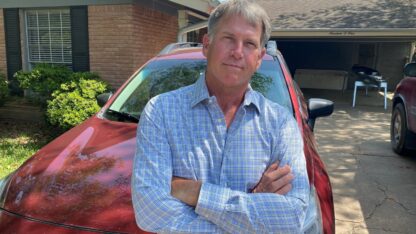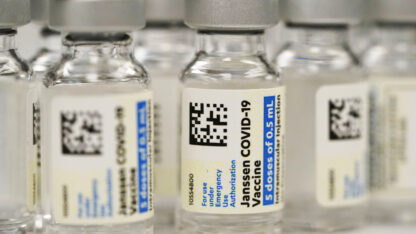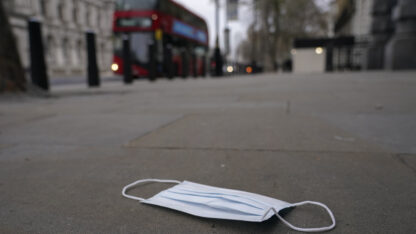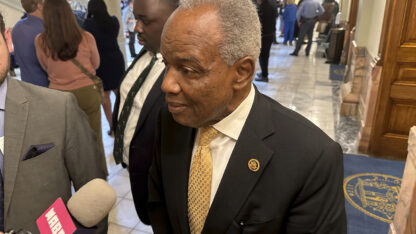One tragic fact about the nearly 1 million people who died of COVID-19 in the U.S. is that a huge share of them didn’t have to.
In Tennessee, 11,047 of the people who died could have survived if everyone in the state had gotten vaccinated. In Ohio, that number is 15,875. In Georgia, it’s 13,598. Nationally it’s nearly 319,000, according to a new estimate.
These figures come from an analysis released Friday by researchers at Brown University and Microsoft AI Health — shared exclusively with NPR — that estimates the portion of vaccine-preventable deaths in each state since COVID-19 vaccines became available at the start of 2021.
In early 2021, when the vaccines were widely distributed, there was huge demand. At the peak of the vaccination campaign in the spring, 4 million people got vaccinated in one day. That demand dropped off by summer. A year later, many states are still barely north of 50% of people fully vaccinated.
How many lives would have been saved if that slump in vaccine demand had never happened? To answer that question, Brown and Microsoft researchers calculated the peak vaccination rate for each state, and then imagined that rate continued until all adults in the state were fully vaccinated.
The total for the country is stark: Many of the nearly 1 million COVID deaths took place in 2020 before the vaccines were available. But of the more than 641,000 people who died after vaccines were available, half of those deaths could have been averted – 318,981 – had every eligible adult gotten vaccinated. And those numbers are even more striking in certain states where more than half of deaths could have been avoided.
“The vaccine rollout has been both a remarkable success and a remarkable failure,” says Stefanie Friedhoff, a professor at the Brown School of Public Health, and one of the analysis’s authors. It was a success, she says, in the sense that “the United States was first in getting those vaccines developed and making doses available at high numbers quickly to the public.”
A lot of money and energy was invested in the logistics of the rollout – the supply side of the equation. Much less was invested in encouraging vaccine demand, she says.
“We did not start early on with information campaigns about why vaccines are important – what do they do for us?” she says. “We underestimated dramatically the investment it would take to get people familiarized with vaccines because, by and large, we haven’t had a deadly disease like this, so people have become estranged from the important impact of vaccination.”
Red state, blue state
The map of states with the most preventable deaths shows a sharp political divide – as NPR has reported, people living in counties that voted for then-President Trump in the 2020 election were three times more likely to die from COVID-19 than people who lived in counties that voted for President Biden.
According to the analysis, West Virginia, Wyoming, Tennessee, Kentucky and Oklahoma had the most vaccine-preventable deaths per capita. Washington D.C., Massachusetts, Puerto Rico, Vermont and Hawaii had the fewest.
The analysis is accessible in an interactive dashboard showing different scenarios to estimate the impact of vaccines state by state, such as a vaccination rate of 85% or 90% instead of 100%.
The national number of vaccine-preventable COVID deaths calculated by Brown and Microsoft exceeds an earlier analysis from the Kaiser Family Foundation, which put that number at 234,000. Cynthia Cox, director of the Peterson-Kaiser Health System Tracker and a co-author of that analysis, tells NPR that differences in methodology may explain the discrepancy.
Unlike the KFF analysis, the new analysis included data on how many Americans were boosted — so the vaccine-preventable death total includes people who never got vaccinated, along with those whose vaccine protection had waned and who had not received a booster.
Of the Brown research, Cox says, “I think this is a really clear way of demonstrating both the effectiveness of vaccines and also the need to continue to vaccinate more people and to make sure that they’re up to date on those vaccines.”
She notes one limitation is that the calculations may be overestimating the impact of vaccines, since the mostly Republican-led states that had lower vaccination rates also underused other pandemic-fighting tools, such as mask and social distancing requirements.
‘A map of trust’
One state that stands out in the analysis is West Virginia, says Dr. Thomas Tsai, a surgeon and professor at Harvard School of Public Health and co-author of the analysis with Friedhoff.
Early on, West Virginia’s vaccine rollout was celebrated as other states struggled to take a stockpile of vaccines and get them into people’s arms.
“There was a very, very early push to get vaccinations out, but a lack of resources to see it through the course of the year,” Tsai says. “West Virginia could have ended up like Maine or Vermont, but ended up being more like Wyoming or Idaho – not for lack of effort, potentially, but for lack of resources.”
A. Toni Young runs a public health outreach organization in West Virginia called Community Education Group, that has worked to vaccinate people against COVID-19 across the state. From her perspective, the drop in the vaccination rate came when the voices of local pharmacies and physicians were overpowered by national voices denying the seriousness of COVID-19 or saying that herd immunity was imminent.
“Folks started to have a conversation within their social networks, and had a real attitude of, ‘Well, someone else has been vaccinated, I don’t need to be vaccinated.’ They also started to see people, particularly in a younger age cohort, get COVID and survive,” Young says.
“I think that we could have had more trusted leaders doing the messaging in West Virginia,” Young adds.
“All of this comes down to trust – whether the political leadership creates the climate of trust in the public health agencies’ efforts, in the science, in the ability of the health care system to deliver,” Tsai says. “To me, this is a map of trust.”
A senior White House official speaking with NPR on background pointed to work the administration has done to invest in community-led vaccination efforts, and said that trust-building was a key part of what the Biden administration is asking Congress to fund.
But the push for more federal COVID-19 funding appears to be stalled. The White House has been asking for $22.5 billion – when Congress got close to a funding deal in April, it would have been for less than half of that. Federal officials warn that this delay could affect Americans’ access to booster shots in the future. Funding for free COVID-19 vaccination, testing and treatment for people without health insurance has already run out.
The patterns found in the Brown analysis could well continue with future COVID deaths piling up in places where vaccination access is poor and hesitancy is high, cautions Friedhoff.
Immunity both from vaccines and prior infection appears to wane over time and further booster campaigns could well be needed to save lives.
“We’re at a point where we have 1 million deaths, but also very little investment and interest in continuing vaccination campaigns and continuing the support for vaccination,” she says. The data underlying this tool is real, she notes – the people who actually got vaccinated and the people who actually died. “The basis for this dashboard is what actually happened, and it can show us – in spite of all the narratives – how many people didn’t have to die.”
It provides evidence and incentive, she adds, to try and support more people in the decision to get vaccinated.
Copyright 2022 NPR. To see more, visit https://www.npr.org.
9(MDAxODM0MDY4MDEyMTY4NDA3MzI3YjkzMw004))
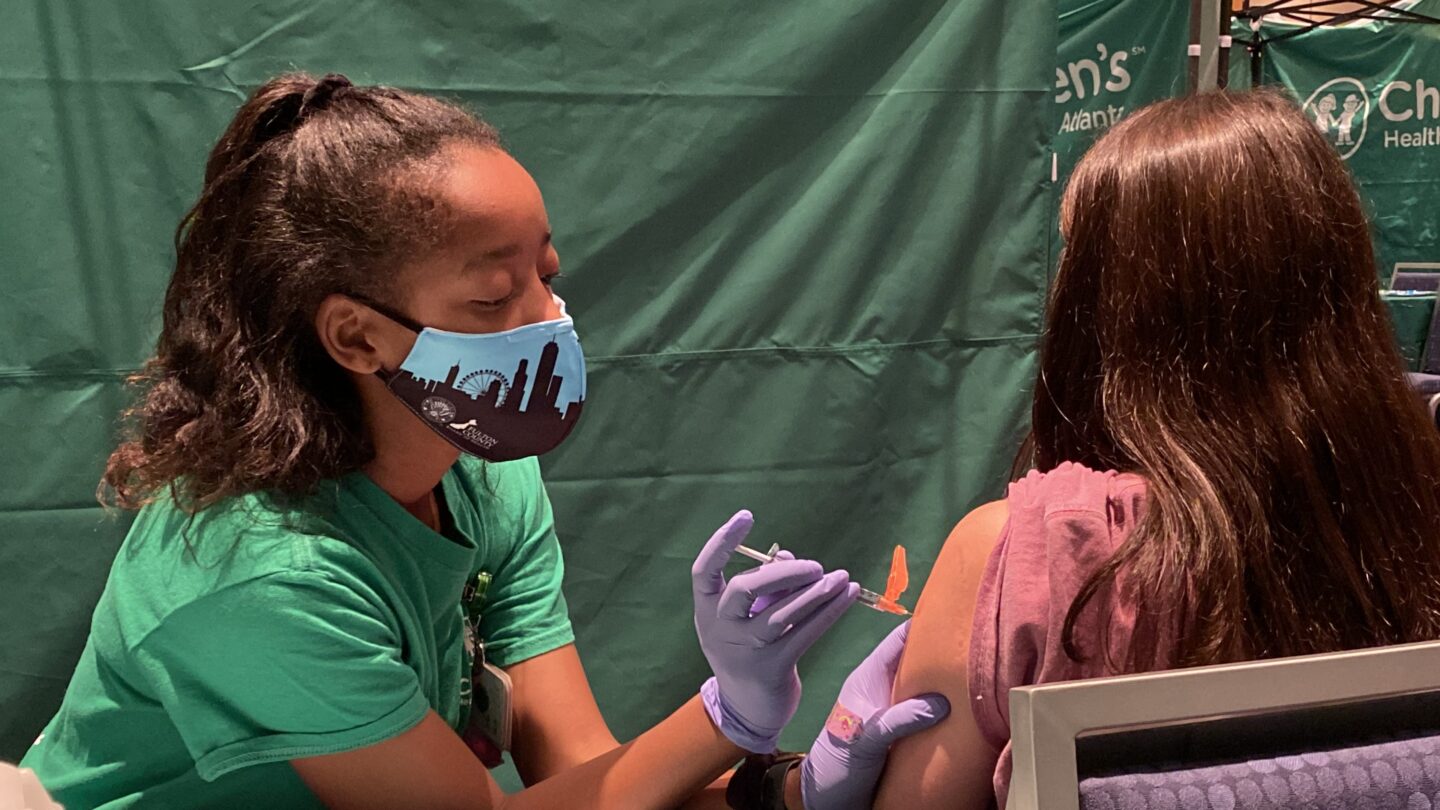
9(MDAxODM0MDY4MDEyMTY4NDA3MzI3YjkzMw004))
